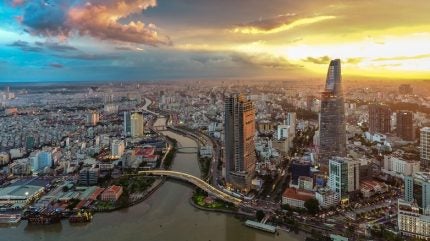
South East Asia is the most attractive location for foreign investment in manufacturing thanks to its competitive labour costs and availability of talent, a new report by Verisk Maplecroft says.
It highlights that India lags behind its counterparts in the region when measured on the strength of its human capital, which encompasses education, health, innovation and productivity levels.

Discover B2B Marketing That Performs
Combine business intelligence and editorial excellence to reach engaged professionals across 36 leading media platforms.
The report measures countries against a cost of labour index (CLI) and a human capital availability index (HCAI). In the global ranking of 192 countries, Vietnam is in 13th place, making it the region’s best-performing country. Other regional actors that rank highly include Indonesia (17th), the Philippines (28th), Thailand (31st) and Malaysia (35th). India is almost thirty places behind (72nd).
In the past few years, the region has benefitted from companies restructuring their supply chains in response to the Covid-19 pandemic and growing tensions between the US and China.
The ‘China plus one’ strategy, where corporations avoid an over-dependence on China by diversifying their investment locations, has directly benefited the region, the report suggests. Manufacturing wages in China – which still ranks highly on the report’s CLI and HCAI list (24th) – have also doubled over the past decade, enabling more competition from other countries. That said, the country’s manufacturing sector remains deeply embedded in global supply chains.
Locations in the Americas and central and eastern Europe have also benefited from a shift in global supply chains. For the US, Mexico has been a key nearshoring destination, although uncertainty regarding tariff rates has already halted some manufacturing investments.

US Tariffs are shifting - will you react or anticipate?
Don’t let policy changes catch you off guard. Stay proactive with real-time data and expert analysis.
By GlobalDataIn Europe, Romania, Bulgaria, Poland and Hungary have been beneficiaries. Lower wages relative to Western Europe and robust vocational education systems have been a major draw for investors. However, a narrowing of the working-age population and a tighter labour market are growing obstacles.
While the ranking places locations such as Georgia, Armenia, Moldova and Ukraine highly due to low labour costs and educated workforces, conflict and political risks undermine these locations’ ability to attract investment.
Current US tariff policy, however, complicates the outlook for South East Asia, which has been threatened with some of the highest levies. While Vietnam’s ability to secure a tariff deal with the US was received positively, the tariff rate still rose to 20% (and to 40% for ‘trans-shipments’ from third countries, which has not been clearly defined).
“Recent US tariff proposals targeting a broader swathe of exporters have clouded the wider regional outlook for South East Asia, but it remains a highly important hub for supply chains,” Verisk Maplecroft senior analyst Jess Middleton says in the report.
The report also touches on the obstacles and opportunities of long-term demographic shifts. While developed economies such as the US and Germany currently have a high HCAI, working-age populations in Western markets are in decline.
Sub-Saharan Africa, despite being the most competitive region in terms of labour costs, faces obstacles such as educational gaps and a lack of workforce development.
However, the report notes that Africa’s working-age population is expected to expand. Nigeria, Ethiopia and Tanzania’s population is expected to grow 40–60% by 2050, creating an opportunity to invest in workforce development and mature the region’s human capital in the long term.





